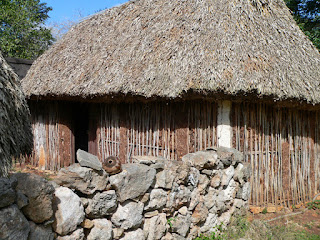When tourists visit the Yucatan, they generally stay in places like Cancun or Cozumel.
We also travel to places like that and have explored many large cities in Mexico, but spend most of our time in less touristy places that are much more interesting to us. We stay at this RV campground, only a short drive from Cancun.
It has a nice pool, great restaurant, empty beaches and great snorkeling and kayaking.
RV's are parked under these roofs and left here year around.
In the Yucatan, a large percentage of the population is Mayan, most of whom speak their own native tongue as well as Spanish, which is now required in school.
Made of vertical sticks tied together, which can then be plastered, a naj is the timeless house in Maya culture.
We have seen identical ones depicted in bas-reliefs of the 1,000 year old Nun's Quarters in Uxmal, one of the Yucatan's more famous archaeological sites.
These houses are found all over the Yucatan, but the most traditional Mayan communities are found in an isolated area of central Quintana Roo State. All together, Mayan ethnic groups speak about 30 distinct indigenous languages.
Many Maya are bilingual, learning Spanish as a second language to communicate in the marketplace. It is still possible, however, to wander into a village where no Spanish at all is spoken by any adults.
Ancient Mayan legend claims that this cave in the town of Mani connects the natural and supernatural worlds.
There are several connecting passages and cave pools that are inhabited by white, freshwater shrimp, often caught for food by local children.
After these friendly kids took us on a tour of their "secret cave", they showed us their homes---














No comments:
Post a Comment